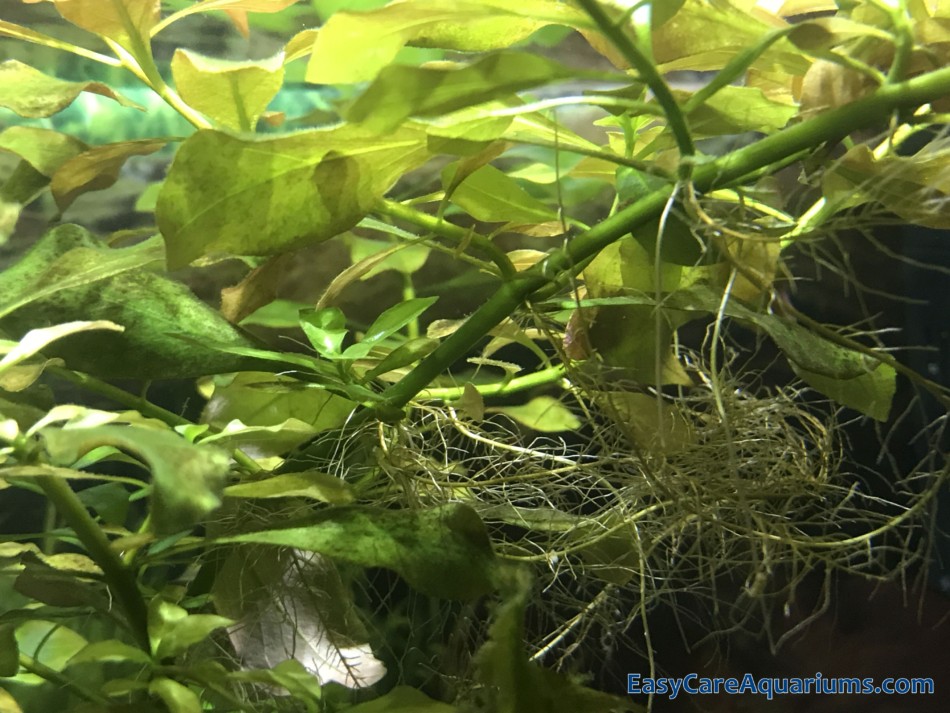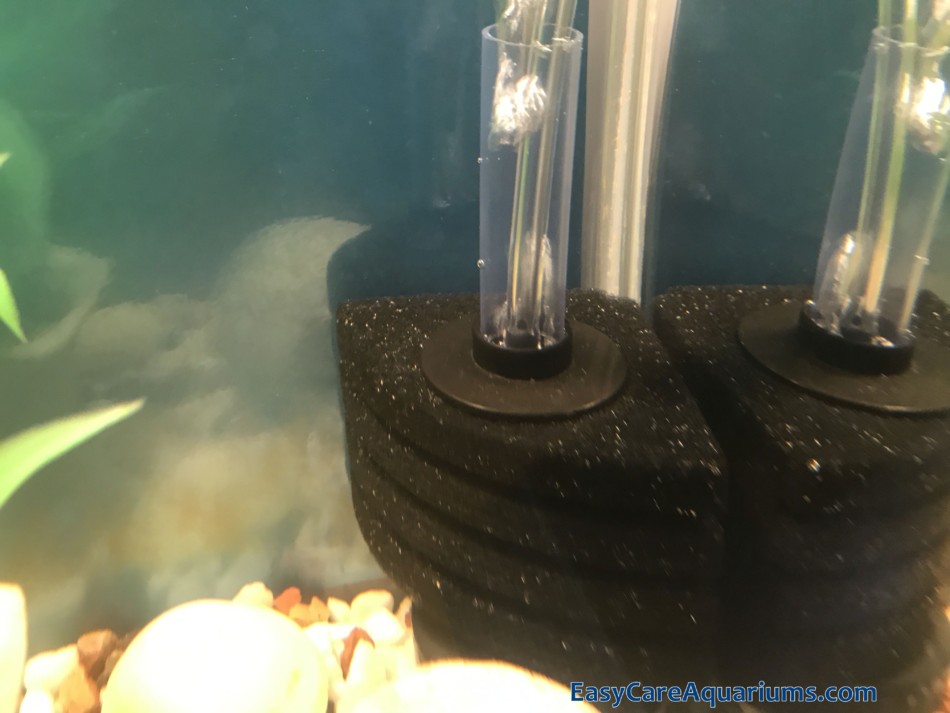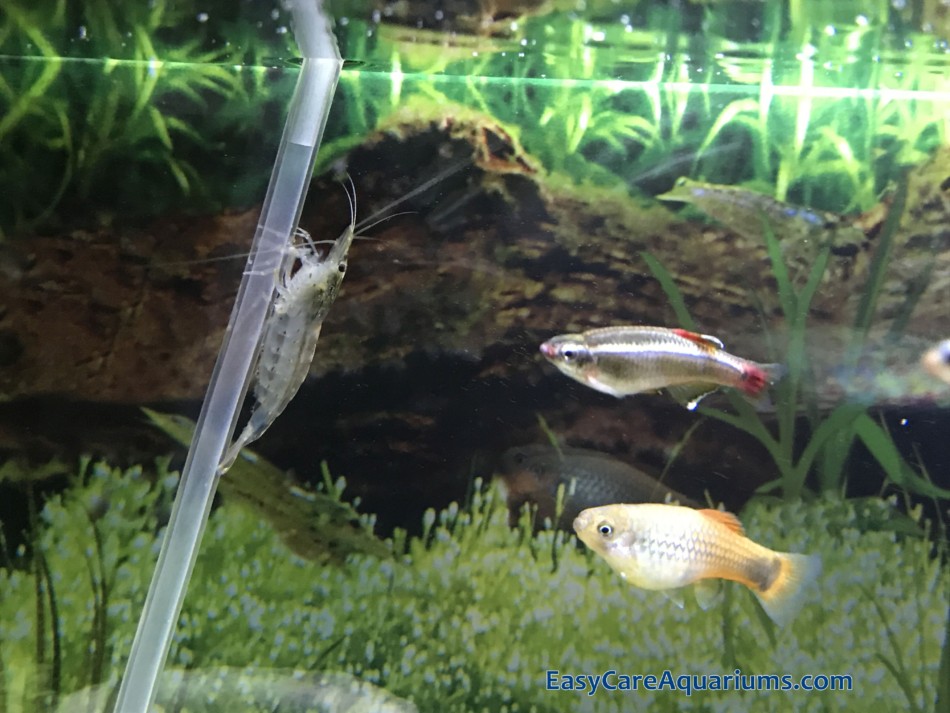This article may contain some affiliate links to products. The links provide me a small percentage of commission but do not cost you anything extra to use. (See full disclosure statement here ).
).
Guppies are not considered to be fussy when it comes to their tank environment. But making things closer to their native habitat can improve their general wellbeing and even their lifespan.
The best tank setup for Guppies is one with plenty of plants, slow to moderate flow and a decent level of light. Because Guppies are a tropical fish the water needs to be warm, clean and oxygenated. And the addition of rocks/pebbles, leaf litter and driftwood, for example, will help to create an environment that they will thrive in.
Whether you’re setting up a Guppy only tank, or adding them to an existing community tank, you can keep things easy-care. It doesn’t need to be complicated to keep them happy and healthy.
In this article I will be explaining how to set up a freshwater tank for your Guppies. I’ll also be giving you some information and tips about adding them to, or building up, a Guppy friendly community tank.
Tip: Decide how many Guppies you want to keep before buying the tank. If you buy the tank first the size of the tank will dictate how many of them you can keep. If you’re adding Guppies to an existing community tank you need to take both the tank size, and the number of established inhabitants, into account before buying more fish.
Choosing A Tank For Your Guppies
Guppies are a schooling fish which means that they prefer to live in groups. It’s best to keep at least 4 Guppies together as a minimum number. They don’t do well if they live alone or are the only Guppy in a community aquarium. Once you’ve decided how many Guppies you will keep you can start looking for the right tank.
Because Guppies are a small fish, especially the males, you don’t have to have a huge tank. It’s one of the reasons why they are a good beginner fish.
However, they are an active fish that swim around almost all of the time. Which means that they need plenty of swim-room. So it’s important that the tank gives them enough space to do this without being cramped.
It’s always best to buy the biggest tank that your budget and available space will allow.
Tip: Guppies, like a lot of livebearing fish, are prolific breeders. If you keep both males and females you will need to allow plenty of extra tank space to accommodate the regular influx of new arrivals.
To find out more about how Guppies breed click the link to read my article ‘How Do Guppies Breed?’
So What Size Tank Do Guppies Need?
The size of tank you will need for your Guppies will depend on a few things. It’s a good idea to take the points below into account before buying an aquarium.
- The number of Guppies you want to keep
- The size of Guppies when they are full grown (Males Approx. 1-1.5 inches/3.8 cm, Females Approx. 2 inches/5 cm)
- Spare litres/gallons for fry when they arrive
- Plenty of room for plants but leaving plenty of swim-room for the fish too
- Room for any other fish/shrimp/snails that will share the tank
As you can see from the list above there are a few basic things to consider when you’re choosing the right tank for your Guppies. And it’s impossible for me to tell you what tank size you should buy because I don’t know exactly what it is you have in mind.
My advice though is to make a plan taking all of the points above into account. Then speak to your local Pet Store or Aquatic Dealer for some guidance on a suitable tank that will comfortably accommodate all of your planned inhabitants and will allow room for fry.
There’s no ‘one-size-fits-all’ when it comes to choosing the right tank for your fish. So having a plan and getting some guidance is a great help. Particularly if you’re new to the fishkeeping hobby.
Note: It’s always better to understock rather than overstock a tank, particularly in a new tank setup. If you add too many fish at once you run the risk of an ammonia spike which can be fatal to your fish. This applies to both a Guppy only tank and a Guppy community tank.
Tip: Guppies can, and do, jump out of the tank. And not only because something has spooked them either. It’s just something that they do. So it’s best to have a close fitting lid on their aquarium to prevent any losses.
What’s The Best Tank Layout For Guppies?
Although the Guppy is an easy-care fish that readily adapts to different tank setups they do better in a tank that provides at least the basic things that will make them feel at home. The closer you make the tank environment to their native habitat the better the chance you have of them thriving.
The Guppy is native to the tropical areas of South and South-North-East of America but are often found in other close by tropical freshwater areas. They typically live in slow moving streams, ponds and small pools of water. However, they’ve also been found in brackish (slightly salty) waters too.
I appreciate that keeping any fish in an aquarium setup is never going to be the same as their native habitat no matter how much you try. However, most of the fish we buy from Pet Stores/Aquatic dealers have been captive bred for many generations and are generally well adapted to aquarium life already. But that doesn’t mean that we shouldn’t do our best to make their lives more comfortable. And if the fish are happier they’re less likely to suffer form stress and stress related illnesses.
Creating a tank that mimics the Guppy’s native home is not only better for your fish but it looks attractive too.
A Good Tank Layout For Guppies Generally Includes:
- Plants – A heavily planted tank, which can include a combination of stem, epiphyte and floating plants for example, is important for a Guppy tank (there’s more information about plants/types both live and fake in the next section).
- Pebbles/Rocks
 – (Amazon Link) Use these to create a more natural look to the bottom of your aquarium.
– (Amazon Link) Use these to create a more natural look to the bottom of your aquarium.
- Leaf Debris – Helps to create a more natural look and feel to the tank. Catappa Leaves
 (Amazon link) are a good choice as they release beneficial tannins into the water. But you can use other leaves such as Oak Leaves for example, for this too.
(Amazon link) are a good choice as they release beneficial tannins into the water. But you can use other leaves such as Oak Leaves for example, for this too.
- Substrate – (Amazon link) Sand/Course Sand
 or Fine Gravel work well in a Guppy tank. But any kind of substrate you prefer is ok.
or Fine Gravel work well in a Guppy tank. But any kind of substrate you prefer is ok.
You can also add pieces of Wood/Twigs (Amazon link) and Alder Cones to create a more natural ‘bottom of the stream debris’ look. It all helps with the overall look and the feel of the tank.
(Amazon link) and Alder Cones to create a more natural ‘bottom of the stream debris’ look. It all helps with the overall look and the feel of the tank.
Tip: Make sure that any wood/twigs, leaves and/or alder cones etc are aquarium safe. This is particularly important if you forage for them yourself. Any natural tank debris needs to be pest and pesticide free or you risk poisoning your fish.
Even if you’re trying to create a natural feel to your Guppy tank it doesn’t mean that you can’t include other tank decertations too. So add the things that you want to see in your aquarium to get it the way you want it to look. Your Guppies won’t mind about your taste in aquarium decoration because they are not a fussy fish.

Do Guppies Need A Planted Tank?
Guppies definitely benefit from having a planted tank. Live plants help to keep the aquarium water clean by using up nutrients in the water in their effort to grow. Plants also provide places for Guppy fry to hide in which is good if you want to save as many baby Guppies as possible. And although adult Guppies are an active fish, that rarely feel the need to hide, they do like a densely planted environment to live in. So, as a general rule, a planted aquarium is good for Guppies.
Also Guppies look great swimming in a planted tank because a planted background really shows off their colours.
If you’re not sure which plants to use, or you haven’t bought live plants before, I’ve got some suggestions for you.
7 Easy-Care Plants For A Guppy Tank
- Anubias – Large leaved plant (needs planting in the substrate)
- Java Fern– Wide leaved plant (can be planted or attached to wood or rocks etc)
- Water Sprite Plants – Lattice/feathery leaves (can be planted or left to float)
- Amazon Sword – Narrow long leaved plant (needs planting in the substrate)
- Java Moss – Fine feathery moss (usually attached to wood/rocks/tank decorations)
- Hornwort – Feathery Plant (can be planted, floated or attached)
- Floating Plants – Such as Frogbit, Red Root Floaters and Large Leaf Duckweed
There are lots more easy-care aquarium plants that you can use in your Guppy tank. Guppy Grass (carpeting), Water Wisteria (planted) and Water Lettuce (floating) are just a few of the options that you can choose from. But the plants in the list above will give you a good starting point.
Check the plants out Online, at your local Pet Store or Aquatic Dealer. Then choose the plants that you want in keep in your aquarium to get the effect you’re aiming for.
Artificial/Fake Plants
I know that not every fish keeper wants to keep live plants. The good news is that you don’t have to keep live plants in your Guppy tank. You can use artificial/fake ones if you prefer. But it’s important to choose ones that have soft leaves and no sharp edges to reduce the risk of injuring your fish. And you need to bear in mind that you won’t get the natural ‘filtering’ benefits that live plants provide. Nonetheless, your Guppies won’t mind that the plants aren’t real as long as they have densely planted areas.
If, over time, you decide to try some live plants in your tank the list and suggestions above will give you a good place to start.
Tip: When choosing a filter for your tank make sure it can cope with the tank’s water capacity and the number of fish that you’re keeping. Some types of fish are messier than others, so remember to take that into account too.
Do Guppies Need A Filter?
Even though Guppies are considered to be a tough freshwater aquarium fish they do need good water quality to thrive in. The easiest way to ensure they have clean, toxin free, water is to install a filter in their tank. Regular water changes and regular tank maintenance are a great help with this too. An aquarium filter is also important for ‘growing’ the beneficial bacteria that help to make the tank environment a healthy one.
Fish keepers do sometimes keep Guppies in a tank without a filter. They tend to use lots of plants for natural filtration and carry out extra water changes to keep the tank healthy. So if you’d rather keep a no-filter Guppy tank, and don’t mind the extra work involved, you can keep a filter-free Guppy tank.
However, the easy-care option is to install an aquarium filter alongside your regular tank maintenance schedule.
Here Are Some Filter Options For Your Guppy Tank
- Sponge Filter – A Sponge Filter
 (article link) run by an air pump provides efficient filtration and oxygenation while only producing a gentle/moderate flow. It also provides a surface area for beneficial bacteria to grow on and won’t suck in your Guppies or your Guppy fry. It’s cheap and easy to clean. And if you attach your sponge filter to an Adjustable Air Pump
(article link) run by an air pump provides efficient filtration and oxygenation while only producing a gentle/moderate flow. It also provides a surface area for beneficial bacteria to grow on and won’t suck in your Guppies or your Guppy fry. It’s cheap and easy to clean. And if you attach your sponge filter to an Adjustable Air Pump (Amazon Link) you can control the flow/filtration to suit your fish.
(Amazon Link) you can control the flow/filtration to suit your fish.
- Internal Box Filter – This type of filter hangs or ‘suckers’ onto the inside of your tank. Often with the water return part above the water level creating a waterfall effect. But the way the water is returned will depend on the type of internal box filter you buy. Some are completely submerged which means you can’t see the filtered water being returned to the tank. Internal box filters can come with replaceable filter cartridges or a simple sponge insert. This type of filter is often included as part of a tank starter kit but can be bought separately.
- HOB (hang-on-the-back-filter) – Just as it sounds this type of filter hangs on the back of the tank. The box part is on the outside of the tank and the intake tube sits in the water. The box part is filled with filter media of all kinds which you can change to suit the needs of your fish. The filtered water is returned to the tank via a lip/spout creating a waterfall effect.
- External Filter– An external filtering system sits outside of the tank. Usually under the tank stand/cabinet and is hidden from sight. The intake pumps the water out of the aquarium into a filtering unit. Then it pumps the water back in again through a return tube once it’s been cleaned. It does this on a regular cycle. However, unless you have a seriously large tank, or you’re running multiple tanks off the same filtration system, you’re unlikely to go for this option.
Tip: If the filter in your Guppy tank has an intake tube, or an open grid intake section, you need to cover it. If it’s a tube intake you can put a filter sponge over the end. If it’s an open grid type cover you can use something like fine mesh or tights/pantyhose to cover the intake. This will stop your Guppies and their fry being sucked in the filter and being killed.
No matter which type of filter you choose it’s important to remember that the flow is better if it’s slow to moderate when it comes to keeping Guppies.

Do Guppies Need A Tank Light?
Guppies need regular periods of light and dark in their tank. One way, and the easiest way, to achieve this is to install a tank light. Although Guppies like a decent amount of light during daytime hours the light doesn’t need to be super bright. And the light needs to be turned of at night to allow your Guppies to rest.
If you find that your Guppy tankmates, or the plants that you have in the tank, need a little more light it’s not difficult to please everyone.
If you have plants that need a brighter light you can use the plants themselves to make sheltered areas for your Guppies. This will give your Guppies the chance to take a break in dimly lit areas during the daytime whenever they need to. And the fish that like high light can spend as much time in it as they like.
Note: The simplest solution when it comes to lighting needs is to choose tankmates and plants that like the same intensity of light in the aquarium.
Do Guppies Need A Heater?
Guppies are a tropical fish which means that they need a heater in their tank. They do better in a stable water temperature of between 22-28 Degrees Celsius/72-82 Fahrenheit. It’s worth noting that the higher temperature range will encourage growth but is also likely to shorten their lifespan. So a temperature nearer the lower end of the range is probably better overall.
Guppies can also tolerate a slightly lower temperature too (around 16 Degrees Celsius/60 Fahrenheit) particularly if they have been aquarium bred for several generations. However, tolerating and thriving are different things. So heating the tank to at least 22 Degrees Celsius/72 Fahrenheit is generally recommended.
Tip: Even if you have a thermostatically controlled water heater in your aquarium it’s a good idea to have an in-tank thermometer too. It’s an easy way to check that your tank heater is working properly. And if you check it daily it’s an early warning if things are going wrong with the tank temperature/heater.
What Kind Of Water Is Best For Guppies?
If you keep Guppies in a freshwater aquarium they prefer harder water. However, Guppies can adapt to different kinds of water without too much trouble which is one of the things that makes them an easy-care fish. Interestingly though, they can also tolerate brackish (slightly salty) freshwater too. Which goes to show how adaptable this little fish can be. Nonetheless, the water does need to be clean/filtered and free from toxins if you want your Guppies to do well.
The easiest way to keep the water clean is to carry out weekly partial water changes and 4 weekly full tank maintenance alongside what your aquarium filter is doing on a 24 hour basis.
Also don’t overfeed your Guppies. Excess food fouls up the water causing dangerous levels of ammonia, nitrite and nitrate that can kill your fish. Guppies are a greedy fish that always look like they are begging for food. Don’t let them fool you into overfeeding the tank.
If you would like more information and tips about what/how much to feed your Guppies click the link to read my article ‘What Do Guppies Eat?’
Tip: When you set up your Guppy tank, and on all water changes, the water should be dechlorinated using a reputable water treatment product. These products not only eliminate Chlorine and Chloramines they also get rid of any heavy metals that might harm your fish.
Two Tap Water Treatments that are popular with fish keepers are Prime by Seachem and API Tap Water Conditioner
and API Tap Water Conditioner  (Amazon links) but there are other tap water treatments/conditioners too.
(Amazon links) but there are other tap water treatments/conditioners too.
Tankmates For Guppies
The best tankmates for Guppies are other small peaceful tropical fish. They can also live happily with non-aggressive shrimp and snails that are suited to a tropical tank setup.
Here’s Some Of The Fish/Shrimp/Snails That Make Good Tankmates For Guppies
- Small Livebearers (e.g. Platy/Molly/Endler – Note: Guppies and Endlers crossbreed. So if you want to keep a pure strain of Guppies or Endlers don’t keep them in the same tank).
- Small Rasboras (e.g. Chilli/Harlequin/Lambchop/Galaxy -aka Celestial Pearl Danio)
- Danio (smaller varieties e.g. Zebra/Pearl Zebra/White and Gold Cloud Mountain Minnow/Dwarf Spotted Danio)
- Small Tetra (e.g. Cardinal/Neon/Rummy Nose)
- Dwarf Gourami (e.g. Honey/Sparkling/Pearl)
- Dwarf/Pygmy Corydoras (e.g. Bronze/Emerald/Peppered/ Panda)
- Otocinclus (a dwarf sucker fish)
- Shrimp (e.g. Amano/Cherry/Wood aka Bamboo shrimp)
- Snails (e.g. Nerite/Ramshorn/Mystery/Rabbit)
There are a lot more fish, shrimp and snails that will live peacefully with your Guppies. But the list above will give you a good place to start. If you prefer something different from the ones I’ve listed above have a word with you local Pet Store or Aquatic Dealer for some more advice.

Can I Add Guppies To An Established Community Aquarium?
You can add Guppies to an established community aquarium as long as the tank environment, temperature and the other tank inhabitants, are a suitable match. Guppies are happy to share their tank with other fish, shrimp and snails, as long as they are peaceful and not big enough to eat them (see list of tankmates above).
You will need to make sure that there’s enough spare room in your tank before adding any Guppies. And you will also need to bear in mind that if you have both male and female Guppies they are going to breed (click the link to read my article ‘How Do Guppies Breed?’). Taking this into account you need to allow extra room for new arrivals which is really important if you don’t want to overcrowd your aquarium.
So, as long as the conditions are right and there’s room for all (with a potential population increase), you can add Guppies to your established community tank.
The Takeaway
I realise that in this article I’ve given you lots of information about ‘The Best Tank Setup For Guppies’. So I thought it was a good idea to create a short list of the main points that I’ve covered.
Here’s The Takeaway
- Buy a tank that’s large enough for the number of Guppies you want to keep and allow plenty of spare room for fry
- Use plenty of plants either live and/or fake in the tank
- Include pebbles/rocks, leaf debris and a fine substrate, to create a more natural environment
- Filter the tank with a slow/moderate flow
- Tank lighting is best kept at a moderate level unless you provide sheltered areas in the tank
- The ideal tank temperature is between 22-28 Degrees Celsius/72-82 Fahrenheit but the lower end of the scale is best when it comes to lifespan
- Water quality should be clean, oxygenated, and free from a build up of toxins
- Tankmates need to be small and non-aggressive
Guppies are a colourful, easy-care fish, that will give you a lot of pleasure and will also brighten up your aquarium.

